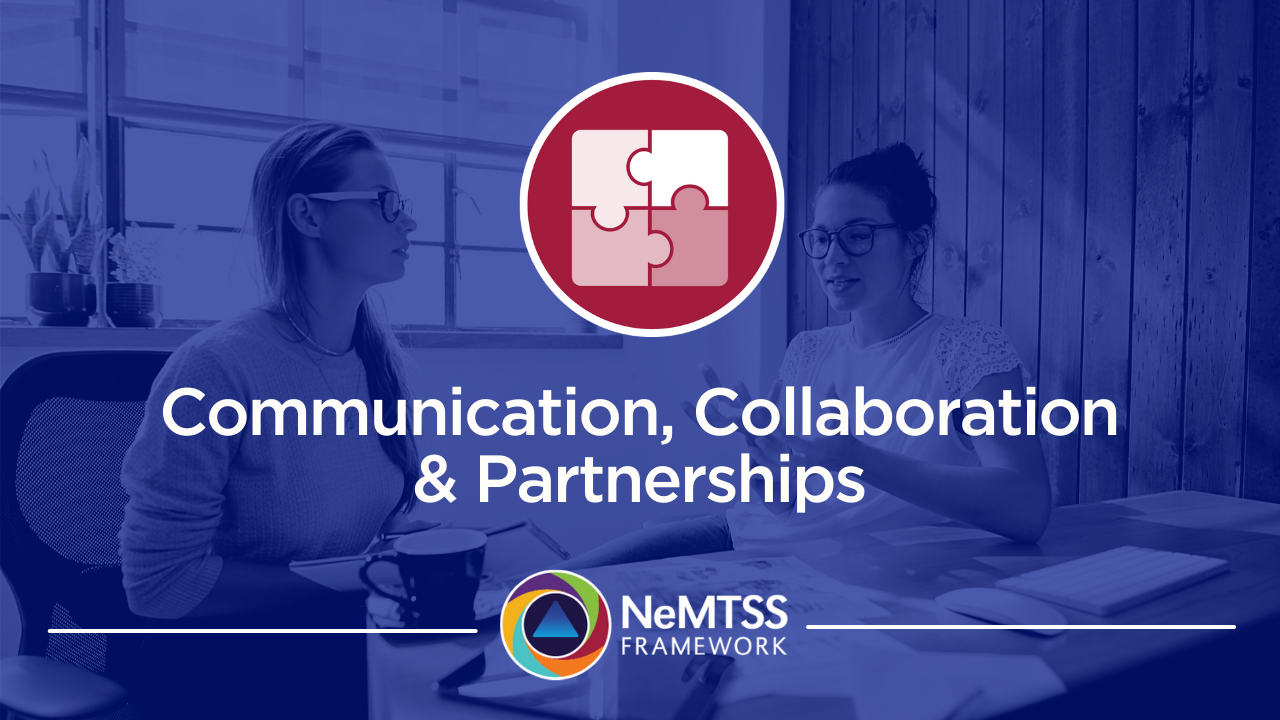Essential Element: Communication, Collaboration & Partnerships
Welcome to the second of our six-part series on the Essential Elements of NeMTSS.
The Essential Elements are the building blocks to a deeply implemented system and are one of the first things districts learn about during day one of System Training. Educators are encouraged to make connections to the Essential Elements within the work they are already doing and determine strengths and opportunities for growth in each of these elements.
Each element is equally important to the process; there is no “most important.”
The NeMTSS Essential Elements are:
- Shared Leadership
- Communication, Collaboration & Partnerships
- Evidence-Based Practices: Curriculum, Instruction, Intervention & Assessment
- Building Capacity & Infrastructure for Implementation
- Layered Continuum of Supports
- Data-Based Problem-Solving & Decision-Making
Today, we will be looking at Communication, Collaboration & Partnerships more in-depth.
Communication, Collaboration & Partnerships
Communication
Effective communication is crucial to the success of a multi-tiered system of support, whether teams are discussing education, collaborating on a new approach or building partnerships among various groups. It is important for families, teachers, support staff, administration and any other group involved in educating students to understand one another, their roles in student support, and how all teams fit together. Team members need to understand one another through a common vocabulary, with everyone focused on continuous improvement. There must be school-wide awareness, understanding and knowledge of the rationale for and structural elements of MTSS. Reciprocal communication between teams is critical to avoid confusion and redundancy.
Collaboration
Ultimately, collaboration means that all groups work together with the same goal: educating students. Educating our Nebraska students should involve everyone and be “whole child” centered. Teams come together often to problem solve, share ideas, analyze data and form plans that drive them toward a solution. Effective communication is vital to teams making progress within an identified plan in order to meet a student’s need, be that academic, social-emotional or behavioral. To develop true collaboration, parents and families must be fundamentally involved in the entire educational experience. Schools should acknowledge that families are active partners with educators to support children’s learning. Additionally, partnering with community resources contributes to a student’s success and should be strategically tied to specific school and family needs.
Partnerships
Partnerships within the school (e.g., professional, learning teams of educators) as well as outside the school walls (e.g., parents and Educational Service Units) are important to provide a high-quality and equitable education to all students.Families of each student in the school, along with community resources, are key partners in all aspects of MTSS, but their roles may shift at each level of support. Using the information parents and families provide about our students is of such high value. Also, families can reinforce classroom behavior and academic expectations, partnering with teachers at the universal level. At more advanced levels of support, families are active participants in evaluating data and in designing, implementing and monitoring interventions. Throughout the process, their expertise regarding the individual student is vital as they provide unique information and participate in home-school coordinated learning.
Why is Communication, Collaboration & Partnerships an Essential Element to NeMTSS?
Communication, Collaboration & Partnerships is essential to NeMTSS because without good communication and working together, schools would exist in a vacuum and appear very one dimensional. Students are multidimensional and creating a culture in which all voices are valued will only enhance their educational experience and ensure future growth and success. Systematically sharing information and feedback is crucial to stakeholder buy-in.
“If we don’t have a systematic way to share that information back with our teams, we experience a disconnect,” said Kristy Feden, regional support lead, Nebraska Department of Education.
Communication, Collaboration & Partnerships are connected to other Essential Elements, like Shared Leadership and Data-Based Problem-Solving & Decision-Making, because without a good foundation of clear communication and equal collaboration, it would be difficult for leaders to work together with Shared Leadership and it would be difficult to have productive problem-solving meetings in which data is analyzed and decisions are made.
Learn more about Communication, Collaboration & Partnerships by visiting our page and check out our communication plan to help you communicate effectively with partners. You may also read the first post in our series exploring Shared Leadership.
Next time, we will look at Evidence-Based Practices: Curriculum, Instruction, Intervention & Assessment.



